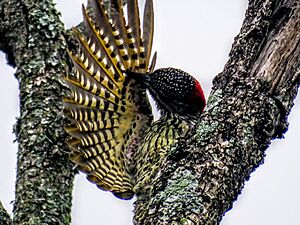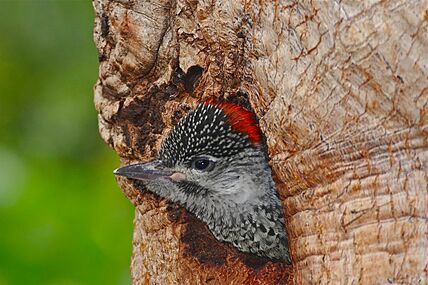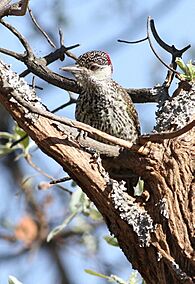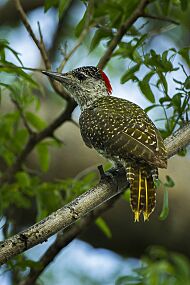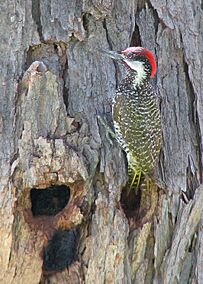Golden-tailed woodpecker facts for kids
The golden-tailed woodpecker (Campethera abingoni) is a cool bird that belongs to the woodpecker family. Its scientific name honors the 5th Earl of Abingdon. This woodpecker is part of a group of similar species, including the Knysna woodpecker and the Mombasa woodpecker.
Quick facts for kids Golden-tailed woodpecker |
|
|---|---|
 |
|
| male of the nominate race | |
| Conservation status | |
| Scientific classification | |
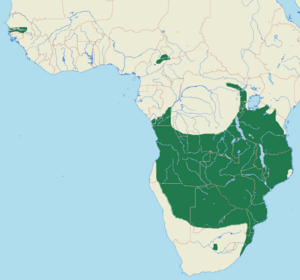 |
|
| resident range | |
| Synonyms | |
|
Chrysoptilus abingoni |
Contents
What Does the Golden-tailed Woodpecker Look Like?
This woodpecker has a unique look. Its upper body feathers are greenish with bars, and its underside has streaks. Its tail is a golden-olive color. This color is similar to other woodpeckers, but its loud, single call helps you tell it apart.
Size and Weight
Golden-tailed woodpeckers are about 20 to 21 centimeters (8 inches) long. Woodpeckers in the southern areas weigh about 70 grams (2.5 ounces). Those in the northern areas, like the C. a. chrysura race, are a bit lighter, around 55 grams (1.9 ounces). Males are usually a bit bigger and heavier than females.
How to Tell Males and Females Apart
The easiest way to tell a male from a female is by their head markings.
- Males have red and brown feathers on the front of their head.
- Females have black feathers with white spots on their fore-crown.
- Males also have red stripes on their cheeks (called malar stripes).
- Females have black and white mottled (mixed) stripes on their cheeks.
Their eyes are usually dark red, and their beaks are slate gray. Their legs and feet are greenish-olive.
Young Woodpeckers
Young golden-tailed woodpeckers have many streaks on their throat and chest. Their bellies have bars. They also have mottled cheek stripes and brownish-gray eyes.
Sounds and Communication
Golden-tailed woodpeckers make a few different sounds.
- They often make a loud, single "waaa" or "weeea" call. The male usually makes this sound.
- They also have a long-distance call that sounds like "yaooaak-yaaaaaak," which they repeat.
- Unlike some other woodpeckers, they drum softly on trees.
Where Do Golden-tailed Woodpeckers Live?
These woodpeckers live in many different types of forests and woodlands. You can find them in:
- Coastal forests
- Miombo woodlands (forests with specific types of trees)
- Mopane woodlands
- Acacia woodlands
They especially like woodlands near rivers, especially in drier parts of southern Africa. They often search for food in the lower and middle parts of trees. They have fairly large territories, usually about 10 to 15 hectares (25 to 37 acres). They can travel quite a distance between their feeding spots.
Geographic Range
The golden-tailed woodpecker is very common in woodlands and forests south of the equator. It is found in many countries, including:
- Angola
- Botswana
- Cameroon
- Democratic Republic of the Congo
- Eswatini
- Ghana
- Kenya
- Malawi
- Mozambique
- Namibia
- South Africa
- Tanzania
- Zambia
- Zimbabwe
And many more across Africa!
What Do Golden-tailed Woodpeckers Eat?
These woodpeckers get most of their food by poking and picking at trees. They also hammer on dead or infected wood more often than some other woodpecker species.
Their diet mainly includes:
- Ants that live in trees
- Termites
- Millipedes
- Larvae (young insects) that bore into wood
- Moth larvae that eat leaves
They sometimes share their habitat with the Cardinal woodpecker. The Cardinal woodpecker tends to find food on thinner branches.
Reproduction and Life Cycle
Golden-tailed woodpeckers build their nests in early summer. Both the male and female work together to dig out the nest. They usually make their nest on the underside of a tree branch, in the lower or middle part of the tree.
Eggs and Chicks
- Females lay two to three glossy white eggs.
- Both parents take turns sitting on the eggs to keep them warm (incubate).
- The male usually incubates the eggs at night.
- The eggs hatch after about 13 days.
- Both parents feed the chicks by bringing them regurgitated (partially digested) food.
- The young birds leave the nest when they are about 22 to 25 days old.
Nest Parasites
Sometimes, other birds called honeyguides lay their eggs in the nests of golden-tailed woodpeckers. The honeyguide chicks then get raised by the woodpecker parents.
Different Types of Golden-tailed Woodpeckers
Scientists recognize about 6 to 7 different types, or "races," of the golden-tailed woodpecker. These races have slight differences in their size, color, or markings. For example:
- C. a. chrysura lives from Senegambia to western Uganda. It is quite green and smaller.
- C. a. suahelica is found from the Kilimanjaro region to northern Eswatini. It has yellower upper parts.
- The most common type, called the "nominate race," lives in southern Africa. It has more streaks on its throat.
Similar Woodpecker Species
It can be tricky to tell the golden-tailed woodpecker apart from other similar species.
- The Mombasa woodpecker has yellower feathers on its underside. Its upper parts are brighter golden-green with small white dots and no bars. It also never drums on trees.
- Cardinal, Bennett's, Reichenow's, and Nubian woodpeckers are all browner on their upper parts and have clearer bars. Only the Cardinal woodpecker has streaks on its underside like the golden-tailed woodpecker.
Gallery



